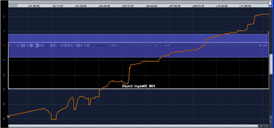This document discusses the speeds used for most analog magnetic tape recording.
See the tape timing chart to convert speeds and lengths into times.
Note throughout most of the rest of this document we are using the correct ISO form of in/s instead of i.p.s. which is the traditional way of stating "inches per second".
15/32 i.p.s. (inches per second)—used for some logging recorders. Uncommon.
15/16 i.p.s.—The Nixon White House tapes were recorded at this speed. Uncommon.
1-7/8 i.p.s.—This is the slowest speed I can easily reproduce and the quality at this speed was never great in reel-to-reel machines. The Philips Cassette has made this speed respectable. Nonetheless, many people used this speed when it became available for the purpose of putting a lot of information on a short reel of tape. It was never considered a professional speed.
3-3/4 i.p.s.—This speed was very common in home use and even some pre-recorded tapes were sold at this speed. It was also used for long-form syndicated music programming in some radio station environments. It is capable of quite reasonable reproduction although the high-end response is still not up to most professional standards. I know of at least one LP that was made from a 3-3/4 i.p.s. archival recording. This was the speed used in the failed Elcaset format from Sony and Pioneer, although the track formats for the Elcaset were different than open-reel (they were arranged like a Philips Cassette) and there were control/data tracks down the center, so playing these tapes in optimum fidelity and channel separation will be a challenge.
7-1/2 i.p.s.—This was the popular recording speed at radio stations and considered the high-fidelity speed by home users. The bulk of the pre-recorded open-reel tapes, at least early on and the high-quality ones, were made at this speed.
15 i.p.s.—This is generally considered to be a professional high-fidelity speed and many recordings were mastered at this speed.
30 i.p.s.—This speed was where tape recording started with the Magnetophon and the Ampex 200 recorders, but was quickly replaced by 15 and 7.5 i.p.s. in day-to-day use. In the 1970\’s and after, 30 i.p.s. was revived for album mastering. The high-output tapes run at 30 i.p.s. provided dynamic range equivalent to Dolby A at 15 i.p.s., but low-end suffers a bit at 30.
Rim Drive—The above all assume capstan drive. You may run across small reels that were made on inexpensive portable recorders. These recorders had reel (or rim) drive so the speed varies throughout the reel. In addition, I would suspect that the speed also varied due to friction and battery condition, in addition to perhaps other factors.
Below (click for larger version) is an image of Samplitude 8.2’s speed automation curve for a roughly 12-minute segment of rim-drive recording. The orange line is the speed correction in half-steps. Note how non-linear it is. I will be the first to say that it’s not a perfect repair, but after an hour of work, I got close. This feature can also be used in a different mode to pitch a mono vocal track on a note-by-note basis.
One thing to consider is that perhaps this was not a rim-drive tape after all, but rather just a broken or improperly threaded tape recorder. We have corrected — using analog varispeed — horribly off speed cassettes. It was a multi-step process, but was a reasonable success.
